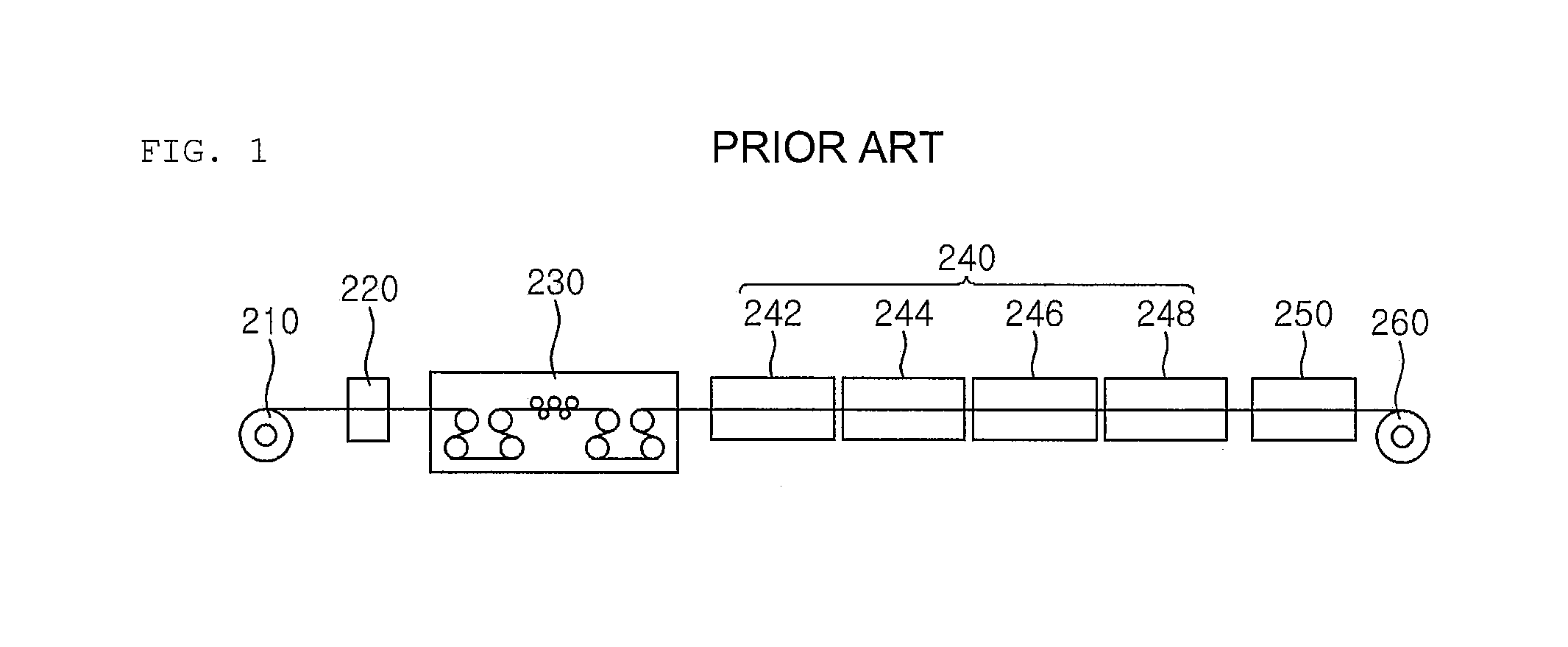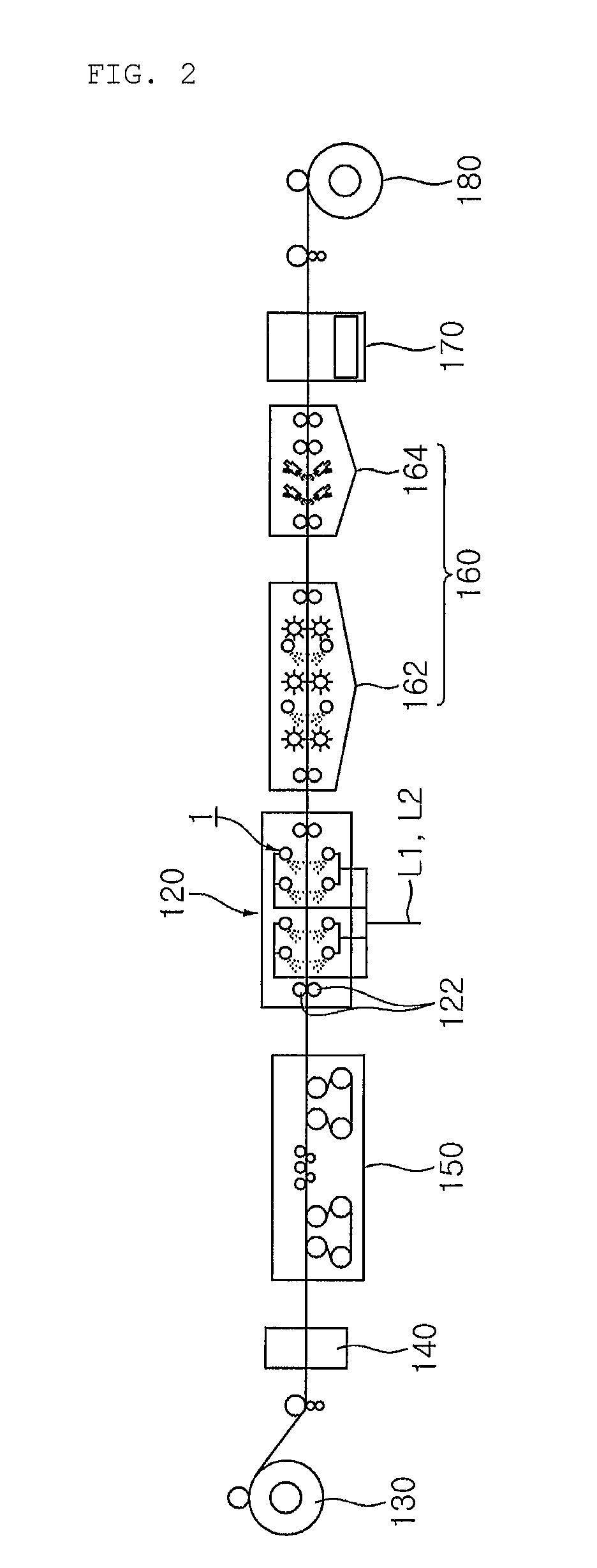Descaling apparatus
a descaling apparatus and descaling technology, applied in the direction of abrasive blasting machines, metal rolling arrangements, manufacturing tools, etc., can solve the problems of increasing the length of the facility, increasing the number of supplementary facilities, and generating environmentally hazardous waste products, so as to achieve high efficiency descaling and be more environmentally friendly.
- Summary
- Abstract
- Description
- Claims
- Application Information
AI Technical Summary
Benefits of technology
Problems solved by technology
Method used
Image
Examples
example 1
[0144]A scale treatment was performed on a hot-rolled low carbon steel sheet (2.0 mm thickness×1200 mm width) at a line speed of 50 mpm based on the process described in FIG. 2 while the steel sheet was continuously passed under the conditions of the following Table 3. As a result, a level of residual scale was less than 1%, similar to that of a typical hot-rolled steel sheet treated by pickling, an average surface roughness of the steel sheet was 1.2 μm, and glossiness of the surface thereof was also excellent.
[0145]
TABLE 3CategoryTreatment conditionScale breakerElongation 1.2%, Amount of bending 20 mm,Surface temperature of steel sheet 50° C.High-pressure sprayAbrasive (glass beads, 150-200 μm),of abrasive slurryspray pressure 200 barSpray conditionSpray angle 15 degrees, Spacing between thedevice and the steel sheet 230 mm
example 2
[0146]A scale treatment was performed on a hot-rolled high-strength steel sheet (4.0 mm thickness×1200 mm width) containing 0.1% of carbon, 1.2% of silicon, and 1.2% of manganese at a line speed of 50 mpm based on the process described in FIG. 2 and under the conditions of the following Table 4. As a result, a level of residual scale was less than 2%, similar to that of a typical hot-rolled steel sheet treated by pickling, an average surface roughness of the steel sheet was 1.5 μm, and glossiness of the surface thereof was excellent and surface defects due to red scale were decreased.
[0147]
TABLE 4CategoryTreatment conditionScale breakerElongation 1.2%, Amount of bending 30 mm,Surface temperature of steel sheet 10° C.High-pressure sprayAbrasive (alumina, 100 μm),of abrasive slurryspray pressure 150 barSpray conditionSpray angle 30 degrees, Spacing between thedevice and the steel sheet 280 mm
example 3
[0148]A scale treatment was performed on a hot-rolled low carbon steel sheet (2.3 mm thickness×1000 mm width) at a line speed of 50 mpm based on the process described in FIG. 2 while the steel sheet was continuously passed under the conditions of the following Table 5. As a result, a level of residual scale was less than 1%, similar to that of a typical hot-rolled steel sheet treated by pickling, an average surface roughness of the steel sheet was 1.5 μm, and glossiness of the surface thereof was excellent.
[0149]
TABLE 5CategoryTreatment conditionScale breakerElongation 2.5%, Amount of bending 30 mm,Surface temperature of steel sheet 50° C.High-pressure sprayAbrasive (glass beads, 80 μm),of abrasive slurryspray pressure 300 barSpray conditionSpray angle 23 degrees, Spacing between thedevice and the steel sheet 150 mm
PUM
| Property | Measurement | Unit |
|---|---|---|
| particle diameter | aaaaa | aaaaa |
| pressure | aaaaa | aaaaa |
| thick | aaaaa | aaaaa |
Abstract
Description
Claims
Application Information
 Login to View More
Login to View More - R&D
- Intellectual Property
- Life Sciences
- Materials
- Tech Scout
- Unparalleled Data Quality
- Higher Quality Content
- 60% Fewer Hallucinations
Browse by: Latest US Patents, China's latest patents, Technical Efficacy Thesaurus, Application Domain, Technology Topic, Popular Technical Reports.
© 2025 PatSnap. All rights reserved.Legal|Privacy policy|Modern Slavery Act Transparency Statement|Sitemap|About US| Contact US: help@patsnap.com



